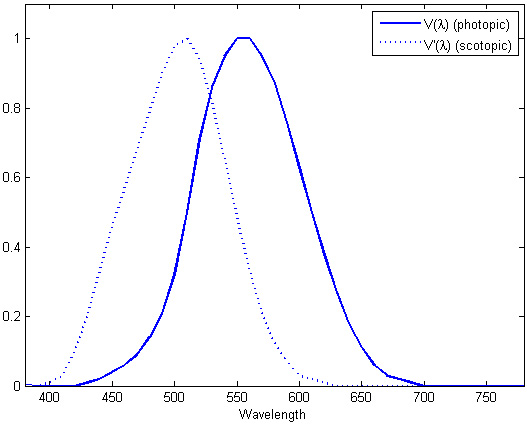The term "light" describes the part of the electromagnetic spectrum visible to the human eye. This region ranges between 380nm (violet-blue light) and 780nm (red light). Similar to the science field of radiometry, photometry studies the measurement of the electromagnetic radiation. However, in addition to the fact that the light is only a small part of the electromagnetic spectrum, the human eye is not equally sensitive to this radiation. Its sensitivity depends on the wavelength of the incident light.
This charachteristic of the human visual system is described by the luminosity function, sometimes referred to as visual sensitivity function. The sensitivity behaviour changes for very low radiation levels (scotopic vision), but in terms of photometry, well-lit conditions (photopic vision) play a major role.
Radiometry studies the absolute power of the electromagnetic radiation (that also includes light). In contrast, photometry considers the eye's response characteristic, weighting the radiation of light by the luminosity function. There are many corresponding photometric and radiometric quantities using different units of measurement. For example, a light bulb emits a certain radiant flux (measured in watts), but only a part of the total emitted radiant power – luminous flux (measured in lumens) – is visible to humans.
Luminous Flux Φ [lm]
Luminous flux describes the total radiance emitted by a light source as perceived by a human visual system. Since the visual system is much more sensitive in green-yellow spectrum than in its red part, the same absolute power of the radiation would provoke a much stronger sensation of green than of the red light. The luminous flux, also referred to as luminous power, is measured im lumens (lm). All the other photometric quantities are related to the luminous flux.
Luminous Intensity I [cd]
In general, light sources do not emit light homogeneously in all directions. The luminous intensity describes the luminous flux emitted within a certain angle in a three-dimensional space (solid angle Ω, measured in steradians (sr)). Therefore, its unit candela (cd) can be substituted by lumens per steradian (lm/sr).
Luminance L [cd/m2]
The amount of luminous intensity that passes through (or is emitted by) a certain area from a certain angle is described by luminance. Taking the solid angle of a humans eye as a measure of spatial distribution of light, luminance describes how bright an emitting or reflecing area would appear. The SI luminance unit is candela per square metre (cd/m2), but sometimes a non-SI unit "nit" is also used (1nit = 1cd/m2).
Illuminance and Luminous Emittance E [lx]
Illuminance describes the quantity of a total light energy weighted by the eye's sensitivity function incident on a certain area. Luminous emittance is accordingly a measure of the total luminous power emitted from a surface with a certain area. They both describe the total luminous flux per unit area. Thus, it is measured in lumens per square metre or lux (lx). Sometimes it is also given in footcandles (fc), that is lumen per square foot (1 fc = 10.76 lux). For example, our integrating sphere LE6-100 provides a maximum luminous emittance of >8000lx.
Luminous Exposure H [lx·s]
Exposure describes the accumulated luminous intensity applied to a certain area (e.g. camera sensor) within a certain time period. In other words, it is the illuminance per unit time. The unit of exposure is therefore lux second (lx·s).
| Photometric quantity |
Symbol | Unit | Definition (simplified) |
Corresponding radiometric quantity |
| Luminous Flux |
Φ | Lumen (lum) 1 lum = 1 cd · 1 sr |
Radiant flux Φe measured in watts (W) |
|
| Luminous Intensity |
I |
Candela (cd) SI base unit 1 cd = 1 lum / 1 sr |
I = Φ/Ω | Radiant intensity Ie measured in watts per steradian (W/sr) |
| Luminance |
L |
Candela per square metre (cd/m²) |
L = I / (A·cos α) | Radiance Le measured in watts per steradian per square metre (W/sr/m²) |
| Illuminance and luminous emittance |
E | Lux (lx) 1 lux = 1 lm / 1 m² |
E = Φ/Ω | Irradiance Ee measured in watts per square metre (W/m²) |
| Luminous Exposure |
H | Lux second (lx·s) 1 lxs = 1 lux · 1 s |
H = E·t | Radiant exposure He measured in joules per square metre (J/m²) |

